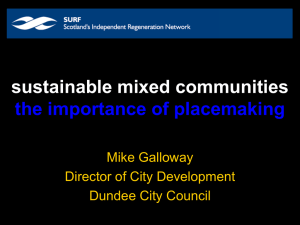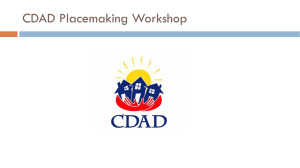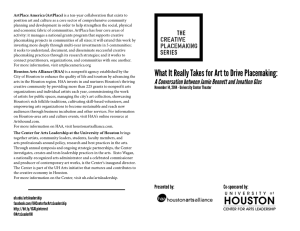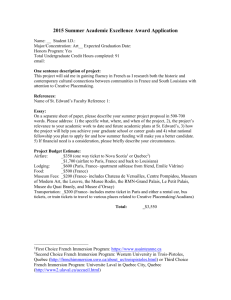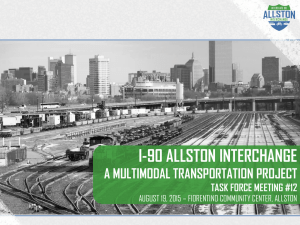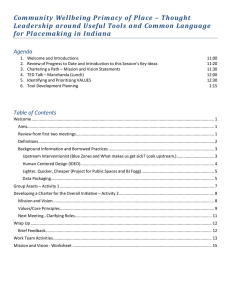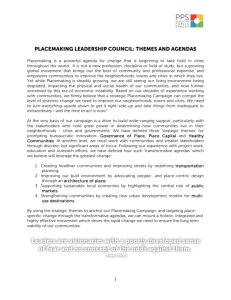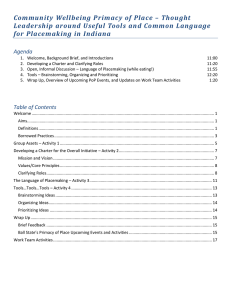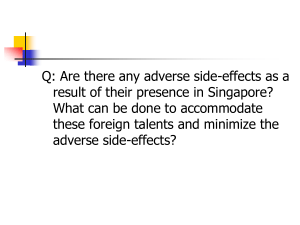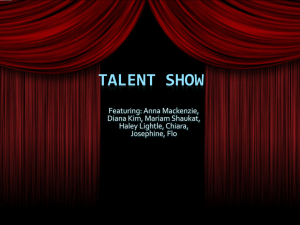gmspa 0531 notes
advertisement
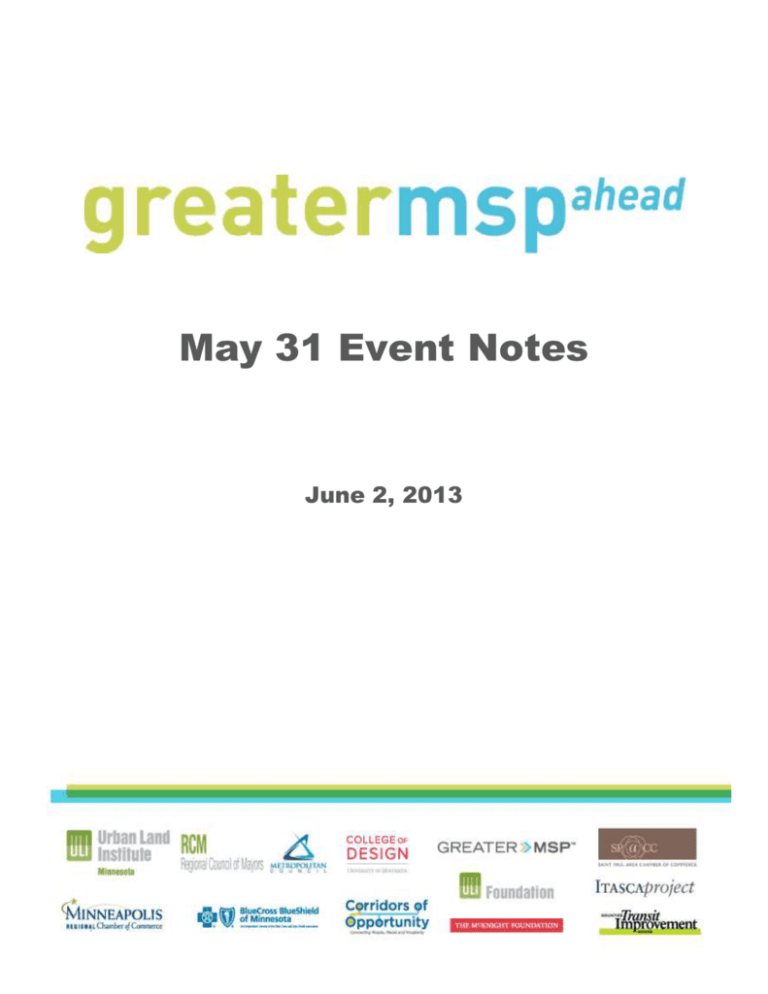
May 31 Event Notes June 2, 2013 THE CALL TO ACTION – THE BASIS FOR THE APRIL 19 AND MAY 31 EVENTS To increase the global competitiveness of the Greater MSP region and achieve sustainable growth in talent, jobs, investment, and the tax base, it’s increasingly clear that we must catalyze bold action to create healthy, resilient communities where everyone has the opportunity to thrive and prosper. MAY 31 EVENT DESIGN The May 31 event was designed to refine and extend the work initiated at the April 19 event. We shared outcomes from the April 19 event, identified work underway, and increased awareness of and energy toward opportunities for action. Participants engaged in two discussions – one regarding the emerging set of regional priorities and one focused on creating a movement – to energize people toward actions that will create the future we desire. Emerging Regional Priorities -- from April 19 Event 1. Build an identity for the regional “competitive unit” Align as a regional operating entity; market our distinctive positioning locally, nationally and globally 2. Cultivate an ecosystem adept at fostering and commercializing innovation and entrepreneurship Make it easier for collaboration, creating and risk taking – elevate and celebrate innovation and entrepreneurship; strengthen mechanisms to attract venture capital 3. Accelerate Job Growth, Talent Attraction, Capital Investment and Exporting Integrate and align regional economic development; match workforce skills with job requirements of employers; catalyze young adults to stay and move here 4. Supercharge our education system Create new forms of collaboration between educators, business, and students to create a new era of innovation, transformation and excellence in education to foster the next generation of talent representing our full community 5. Improve placemaking and connectivity Implement an integrated multi-modal transportation system that facilitates connection and access, a full range of housing choices, land use density, and parks and trails to create more walkable, healthy, and vibrant communities 6. Develop resilient infrastructure that connects regional job centers Leverage technology and innovation to support a more adaptable system to address changing demographics and market preferences, including the ability to respond to natural disasters, e.g. transit build-out, roads, bridges, airports, electrical grid, high speed broadband 7. Conserve and leverage our natural resources as a key regional asset Address threats to regional assets and quality of life for future generations through a high quality water supply, protection and regeneration of topsoil, clean and renewable energy, and reduction of our carbon footprint Areas to Create Momentum and Take Action – from April 19 Event Increase the diversity of the engaged group Continue this conversation – keep the “doing energy going” Increase comfort with risk Invest in citizen participation infrastructure Enable quicker decision-making Enable more effective decision-making Connect bottom-up and top-down efforts Decentralize and crowd source 1 MEETING NOTES PRIORITIES General 1. All of the priorities are interconnected – do we need a grid instead of a list given the relatedness? 2. Priorities are high-level – let’s get to tangible objectives and actions 3. All of the priorities are deficit-based – some should be positioned as celebratory (e.g., yes we need to protect our natural resources, but it starts from a place of celebrating our great natural resources) – more energy in celebrating than solving How We Describe the Priorities #1 Build an identity 1. Encourage and celebrate diversity. We are known as Prairie Home Companion. Shift the perception based on the reality of how we’re changing 2. Piggyback on the trend of globalization – the Greater MSP is an intercultural, global metro area 3. Increase emphasis on citizen engagement – we lead in voluntarism and voter participation 4. Culture of urban life within a natural setting 5. Our stories need to speak to entrepreneurship and innovation – too much focus on Fortune 500 6. Greater emphasis on North Shore – Seattle has Cascades, SF has Tahoe, Denver has Rockies 7. Reword and move down – could be part of a new #8 – “Be a global city – recognize the added value of culturally distinctive places and celebrate and highlight them” #2 Cultivate Innovation and Entrepreneurship 1. Making progress here is essential to #3 #3 Accelerate job growth, talent attraction, capital investment and exporting 1. Reshoring of jobs and diversity are dimensions of talent attraction 2. View immigrant populations as global resources 3. Add talent retention and minimize youth language – many entrepreneurs are 60+ 4. Change to “Accelerate talent attraction and retention, capital investment, and exporting” and add to definition, “create a welcoming place for people of all backgrounds and leadership opportunities for people of different backgrounds” #4 Supercharge our education system 1. Replace with “Make our education system work for all: tackle disparities, focus on what works, adapt to a changing world.” 2. Can we look at education from child point of view? 2 #5 Improve placemaking and connectivity 1. Take prominence off of transit as the pinnacle and focus on connectivity as a whole 2. Transit is a component of increased opportunity 3. Improving connectivity involves eliminating barriers (physical and psychological) as much as actually building and creating new connections 4. Add cultural; move placemaking elements first 5. Reference “creative” placemaking (i.e., incorporation of arts and cultural events and icons into increasingly rich places, especially in transit way station areas 6. Placemaking and connectivity aren’t fitting into existing institutional frame –needs more attention 7. Combine #6 into #5 – Improve placemaking, resilient infrastructure and connectivity #6 Develop resilient infrastructure that connects regional job centers 1. Link built infrastructure and health 2. Infrastructure that connects globally – key to sustainability – see also “nimbleness” 3. Include freight – a key will be figuring out how we move stuff; pay attention to rail #7 Conserve and leverage our natural resources 1. Highlight natural resources as an economic driver – protect the environmental infrastructure 2. This priority makes all of the others possible Missing / Adds 1. Quality of life that reflects levering new technology and innovation (e.g., smart initiatives), supports the growing elderly population (housing choices in neighborhoods), and reflects our responsibility to future generations; Key metric: Gross National Happiness 2. Health care needs to be more prevalent across the priorities 3. Ethnic and racial disparities should be explicit versus implicit throughout 4. Food and agriculture 5. The Arts – unique and feeds into multiple priorities (placemaking, education, attraction) 6. Our people – culture, civic involvement, changing demographics 7. Clear vision and common objectives for the region Most Important (ordered by frequency of mentions) 1. Natural resources (#7) 2. Education / Equity (#4) 3. Placemaking (#5) 4. Integrated regional economic development – operationalizing regional alignment – e.g., in planning, and zoning standards – key to success relative to all priorities (combination of # 1, 2, 3) 5. Infrastructure (#6) 3 ENABLERS FOR EFFECTIVE ACTION General 1. Process for engagement has to be two-way versus imposed 2. Maintain a customer-service focus – constantly listen 3. Make it non-partisan 4. Risk-taking within government should be reframed as making room for compromise 5. An individual community’s level of investment in their “place” is both the ironic help and hindrance of moving ideas Actions Taken / Actions in Process 1. Charm bracelet: creative placemaking projects around transit way stations 2. Urban organics – started with Hamm Brewery 3. Flywheel project – a plan for 14,000 Central Corridor jobs 4. Forever St. Paul crowd sourcing platform 5. Corridors of Opportunity – community engagement grants 6. Citizens League Generation Now leadership visit – people impacted by a problem need to be given leadership skills to advocate 7. Met Council – a more deliberate engagement strategy 8. Trust for Public Land – privately owned open spaces for the public that enhance the community environment 9. Green Step Cities – push out from the center; very locally based approach to addressing climate change 10. “Hackathon” – using open-source data to visualize solutions to community problems 11. St. Paul $2M challenge 12. City of Minneapolis in long-range planning – evaluating software for engagement, smart technology, future dweller expectations, civic entrepreneurialism 13. The Met Council is conducting listening sessions as part of Thrive 2040 – deep into developing longterm plan that will be completed later this year or early next year 14. GREATER MSP is preparing a 3-year strategic plan also due out later this year or early next year 15. Together the Met Council and GREATER MSP are focused on economic development and how to partner to drive decisions and actions Ways to Leverage 1. Use EBS Federal program 2. Use citizenship to replicate with our own ingenuity 3. Link a diverse group with decentralized action 4. Fund small efforts and groups to activate and transform their communities 5. Live out your value – e.g., ride the bus, visit parts of the city you don’t always go to 6. Go to where the people are – make it easier to opt in than out 4 New Initiatives – notes clustered into three key areas that emerged Engagement 1. Continuing these kinds of discussions – the most authentic I have experienced—will move us forward 2. The conversation that is happening here is happening in other silos – we need cross-conduit connectors 3. Replicate this process in sub-regional units – suburbs and outlying counties, school districts, business leaders, universities 4. Develop a shared vision – build alignment around collective success 5. Develop new forms of engagement through technology (e.g., Web 2.0) – and develop new ways to use this input to act differently 6. Share solutions for similar issues (e.g., Andover and North Minneapolis) 7. Be a bridge between “top” and “bottom” interests 8. Add grass root groups in communities and in communities of interest such as bike advocacy groups and urban agricultural groups 9. Use emotion as a lever 10. We need PR to document successes and facilitate replication 11. To be ambassadors, we need a common set of talking points Risk-Taking 1. Take a venture approach where risk / failure is more acceptable (e.g., venture philanthropy, venture government like the federal Tiger grant) 2. Experiment, fail quickly, learn, iterate, progress (lever the model of ecosystems with patching) 3. Innovate new elements of the economy to replace those benefitting from dysfunctions (e.g., obesity and the food system) 4. Use different language – “invest” vs. “spend”. Conduct R&D through pilot projects. Funding 1. Foreign direct investment 2. Make “regional” priorities “state” priorities 3. Use benchmarks to track and demonstrate results What I Can Do 1. Will take message and invitation to councils representing diverse groups 2. Will take message with college presidents to discuss how to engage students 3. Opportunities with intercity leadership development initiative 4. Will take to Regional Council of Mayors – may extend to all council members, boards and commissioners 5. Will move transit case forward – can use help 6. Will take this message to my networks, including group considering us for the 2022 World’s Fair 5
